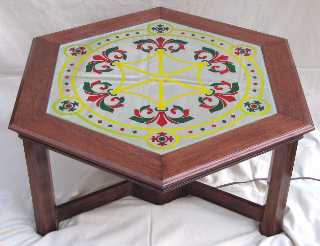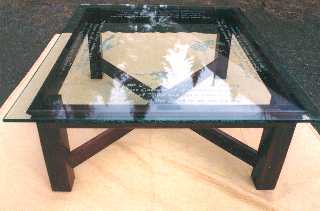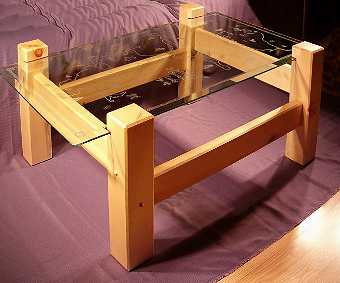 Sand etched glass can add quality and uniqueness
Sand etched glass can add quality and uniqueness
to tables as tops or insets, or other furniture
as artistic detailing (borders/flourishes) or design.
Etching can be added in various ways to furniture:
 Description of Image: This solid mahogany coffee table I made with a hexagonal top and a
mirror insert.
Description of Image: This solid mahogany coffee table I made with a hexagonal top and a
mirror insert.
The mirror is sand etched using a hand cut resist (stencil) on the rear surface,
which removes the mirroring.
The etch (based on a Victorian style ornamentation) was then coloured with transparent glass inks.
It is lit from the underside with
a spotlight fitted as an integral part of the design,
between the three hexagonal legs.
Size shown: 34" (86 cm) top with insert of 5 mm mirror; 18" (46 cm) high
Cost: Is totally dependent upon the complexity of the etch, and what is to be included.
The shown coffee table (etched mirror, coloured, and finished table) would cost $3600 US.
The etched insert only, (with design similar to one shown) would cost $600-800 US.
Click on the image to view details of this table
 Description of Image: The solid mahogany coffee table is 18" high, with 3" square legs, and cross ties with a fitted central hub. Finished in dark mahogany. The ½" thick clear glass top is 40" square, and has a different verse from the Rubaiyat of Omar Khayyam sand etched on each side. Above each verse is an image related to the verse. Everything is etched on the bottom of the glass using a hand cut resist (stencil) for the lettering, and photostencil technology for the 4 images.
Description of Image: The solid mahogany coffee table is 18" high, with 3" square legs, and cross ties with a fitted central hub. Finished in dark mahogany. The ½" thick clear glass top is 40" square, and has a different verse from the Rubaiyat of Omar Khayyam sand etched on each side. Above each verse is an image related to the verse. Everything is etched on the bottom of the glass using a hand cut resist (stencil) for the lettering, and photostencil technology for the 4 images.
Size shown: 40" (102 cm) square top of ½" (12 mm) thick glass; 18" (46 cm) high
Cost: Is totally dependent upon the complexity of the etch, and what is to be included. The shown coffee table (etched glass and finished mahogany table) would cost $4200 US.
Click on the image to view details of this table
 Description of Image: The solid white pine coffee table I've made with legs of 4" x 4" pine, and the stretchers of 2" x 4" pine. The stretchers are tongued into each leg and then pinned in place. Each corner of the legs and the top corners of the stretchers are all chamfered to avoid easily marking them.
Description of Image: The solid white pine coffee table I've made with legs of 4" x 4" pine, and the stretchers of 2" x 4" pine. The stretchers are tongued into each leg and then pinned in place. Each corner of the legs and the top corners of the stretchers are all chamfered to avoid easily marking them.
The 3/8" glass top is slid through notches in each leg that has felt on the bottom for the glass to rest on. The etching on the table top uses a hand cut resist for the map of the lake and photostencil technology for the names of the coves, islands and peninsulas etched near or on each of them. Etched around and on the map are indigenous trees, plants, animals and birds. There is also a map border etched completely around the top, inside the bevel. All the etching is done on the underside of the top, to make it easily cleaned. The piece is signed and dated in the lower left corner of the top. Finished in clear laquer.
Size shown: 25" x 46", 3/8" glass top with a 1" beveled edge; 18" high
Cost: Is totally dependent upon the complexity of the etch, and what is to be included. The shown coffee table (etched glass, and finished table) would cost $1600 US. The etched insert only, (with design similar to one shown) would cost $950 US.
Click on the image to view additional pictures and details of this table
E-mail me with your ideas, and sizes. I'll quote you on the cost of supplying the etched substrate, or the entire piece.
Because of the method of sand etching glass, I must use a new resist with each etched piece. It is impossible to remove and reuse a hand cut vinyl resist, or a photoresist because the vinyl is cut in place on the glass, and the photoresist is glued onto the glass - both are ruined during removal.
Home ~ Heraldry ~ Partitions ~ Art ~ Tankards ~ Plates
About Me ~ Glass Etching Introduction ~ Quote/Order Information

 Description of Image: This solid mahogany coffee table I made with a hexagonal top and a
mirror insert.
Description of Image: This solid mahogany coffee table I made with a hexagonal top and a
mirror insert. 
